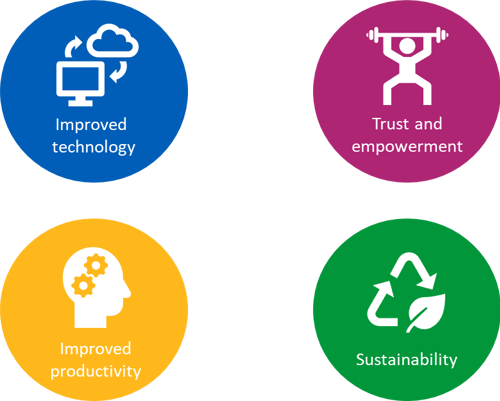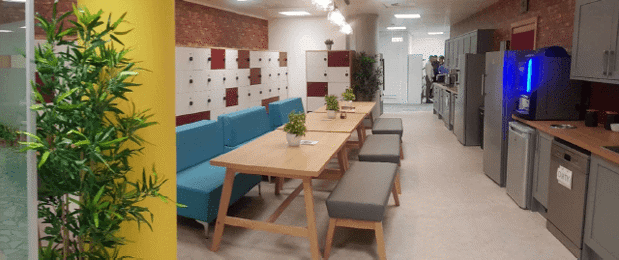
Published date: 18 December 2019
Making the NHS work smarter: introducing agile working
Smarter working is becoming the norm across all sectors, transforming office spaces to enable more flexible and collaborative ways of working. But how does this apply to the NHS? Kate Richardson, Head of the National Office Programme at NHS Property Services, writes on the benefits and opportunities for making NHS office space smarter and how her team is leading the way.
The NHS estate goes beyond clinical space alone, with offices making up a significant portion of space and cost. Within the NHS Property Services (NHSPS) portfolio alone we have over 400 office holdings, spanning 400,000sqm and serving multiple NHS bodies. This means, with some strategic property expertise, there’s a significant opportunity to help drive efficiencies and achieve savings for the NHS. The National Office Programme are already proving this, achieving £75 million in savings over a five-year period for the NHS so far. And we have a strong pipeline ahead – office space makes up 60% of the total value of leases NHSPS has with an event in the next five years.
However, it’s not just about saving money, and we also have a chance to improve working environments and support NHS staff’s productivity and wellbeing. I think it’s important that the National Office Programme isn’t seen to be just taking space away from NHS staff – it’s about giving them the right environments and facilities to be productive.
Benefits of smarter working
Smarter working is achieved by an organisation empowering its people to work where, when and how they choose through maximum flexibility and minimum constraints. The projects the National Office Programme team work on often raise the opportunity to develop smarter working spaces when we are consolidating, refurbishing or acquiring new office space.

This new approach to office space have obvious cost benefits and enables flexibility for an organisation’s strategy (right-sizing both their workforce and estate). However, it also supports sustainability agendas, with employees working from home or not making unnecessary journeys to meetings reducing the need for travel.
And most importantly it has a huge potential to improve the trust and empowerment felt throughout organisations, impacting levels of productivity, wellbeing and retention. We are moving away from measuring employees’ performance by the hours they’re seen in the office, and employers need to give teams the freedom to work where and how they need, to get the job done.
How to implement smarter working
- Communication and engagement
The most fundamental step is to engage employees at all levels throughout the project. This means we can set the correct message, emphasising the benefits smarter working can offer rather than what it can be perceived to take away. A true dialogue is needed, with employee concerns and suggestions fed back into the project, for example co-designing the new co-working spaces.
- Data and designing the workplace
Office space enabling smarter working needs to be designed to offer a variety of workstations, not allocated by status or symbolism, and with ample space for meetings and collaborative working. This needs to be built on a foundation of data, with utilisation studies often providing hard evidence that an 8:10 desk ratio (8 desks to every 10 employees) being the maximum we need.
- Culture and people
Introducing smarter working requires a shift in an organisation’s mindset, promoting a performance driven culture over time spent at desks. This is a particularly tough one to introduce, but an important rule is ensuring agile working is available to all, not just senior management.
- Technology
It is pointless to discuss smarter working without the right infrastructure in place to enable it. Modern IT equipment needs to be provided to all employees to enable mobility, and collaborative tools like Skype will enable efficient remote working. The tools alone are not enough, and employees need to receive regular training to ensure they’re being effectively used.
Proving our value: case study of smarter working
The National Office Programme have many examples of projects where we’ve enabled smarter working as well as achieved savings for the NHS.
One of them is 120 The Broadway, an office block in Wimbledon in which the local Clinical Commissioning Group (CCG) had eight separate leases with the landlord. They had break options in June 2019, and so we worked with them in the lead up to this to establish their true demand profile, finding they had far too much space for their needs and had a significant opportunity for consolidation.
We designed up the space the CCG did need, negotiating with the landlord to consolidate our leases to 2 floors, saving the NHS £6 million. But this space needed a re-design to fit a higher density, and so we oversaw the re-fitting works to deliver a more agile and fit-for-purpose workspace. We used an 8:10 desk ratio, built meeting booths and break out spaces, and provided mobile technology (laptops and phones). The occupants were delighted with the new space, opened in early 2019, reporting improved working culture, wellbeing and collaboration.

(See the full case study here).
My team are constantly building our expertise in delivering more efficient and smarter working spaces and would love to support on new projects across the NHS. If you have any questions or would like to discuss a project with me, please get in touch via our Customer Service team.
Kate Richardson, Head of National Office Programme, NHS Property Services
Kate also recently spoke about smarter working on a webinar, which you can watch here.




